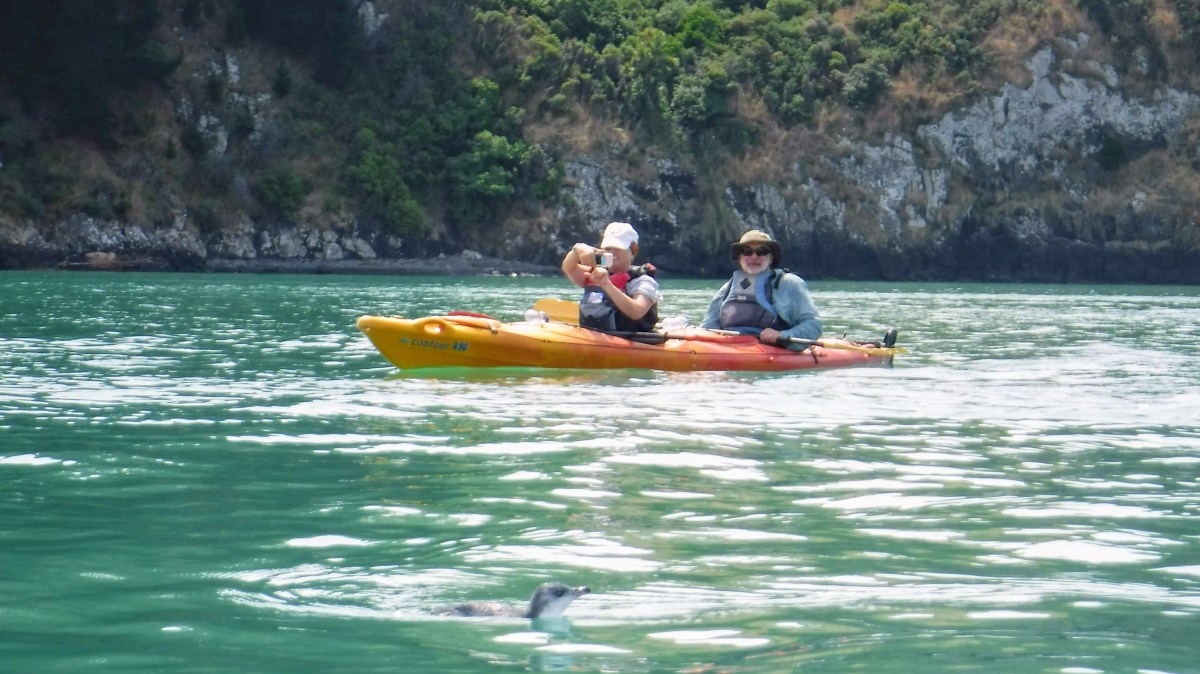What Do They Look Like?
The White-flippered Penguin is the smallest penguin in the world! It has an overall blue-grey appearance, which is very similar to the Little Penguin (Blue Penguin) we like to think they are cousins!.They are distinguished with broad white trailing and leading edges of the flipper. They typically grow to 30 cm tall and weighing 1.5 kg. We see them when they are out fishing in the marine reserve which is really a special experience for visitors to witness them washing themselves and swimming around looking for food.
Most tourists would only witness penguins walking in from the sea at dusk as they are returning to their nests, so kayaking and seeing them in their natural habitat is a real treat!

Where Do They Live?
The White-flippered Penguin is endemic to Canterbury, New Zealand. They breed only on Banks Peninsula (2,200 pairs) and Motunau Island (1,800 pairs). It is considered to be the one and only indigenous creature unique to Canterbury, New Zealand!
Nesting
White-flippered Penguins lay their eggs in a burrow lined with plant material, or in hollows under bushes or rocks, in dunes, or on vegetated slopes of coasts and islands. They feed on small shoaling fish or squid, and sometimes on crustaceans.
Are They Endangered?
The most recent estimate of the total population is only 4,000 pairs (1,800 on Motunau Island and 2,200 on Banks Peninsula). IUCN (The International Union for the Conservation of Nature and Natural Resources) and Birdlife International classified White-flippered penguin as “Endangered”, and D.O.C. (Department of Conservation, New Zealand) as “Acutely-Threatened”.
Why Are They Endangered?
Before European settlement started around 1850 to Banks Peninsula, there were tens of thousands of White-flippered Penguins. They have disappeared from much of their range since then, and are in much reduced numbers where they have survived. Human settlement destroyed habitat outright and predators have overrun many of the remaining colonies.
In a recent study, the aggregate number of nests declined from 489 to 85 between 1981 and 2000: an overall loss of 83%. On Motunau Island where no human lives and without any predators the population has been stable.


What Is Threatening Our Penguins?
The key land-based threats to White-flippered Penguins continue to be predation by introduced predators and habitat degradation by human activities. Ferrets, feral cats and stoats are the main predators. Also, domestic dogs could be a major threat.
At sea, White-flippered Penguins have been frequently caught in near-shore set nets, especially around Motunau Island. A large oil spill would be disastrous to this penguin, and the threat is high because the birds nest in areas near shipping lanes.
Help Us Protect Our Marine Reserve
- No fishing of any kind.
- Don’t take or kill marine life.
- Don’t remove or disturb any marine life or materials.
- Don’t feed fish – it disturbs their natural behaviour.
- Take care when anchoring to avoid damaging the sea floor.
What Can We Do to Save Them?
Some farmers on Banks Peninsula have been privately taking actions to protect White-flippered penguins by banning dogs on beaches. DOC has introduced trapping in many areas and NZ as whole aims to be predator free by 2050.
Most importantly we can all do our part to clean up our oceans and saying no to using single use plastics which is ending up killing alot of our sea creatures.


Emergency Hotline
Call 0800 DOC HOT (0800 362 468) immediately if you see anyone catching, harming or killing native wildlife. This is a FREE call when travelling in NZ
